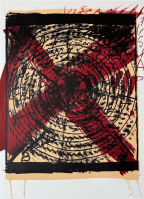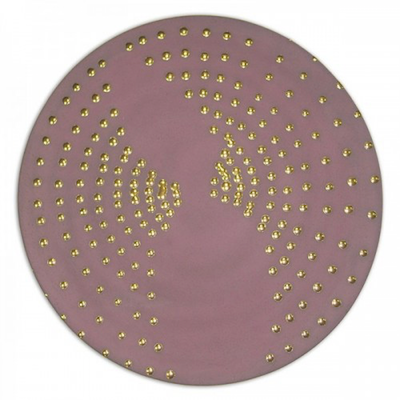
Details
Artist
Styles
Lithography; 100 copies; Artwork size: 76 x 56 cm. Perfect condition // Frigoli 10 by Antoni Tàpies, produced in 1969, is a lithograph that captures Tàpies' abstract approach through soft, organic forms and muted colors. The central element resembles a white, fan-like structure or a delicate shell, spreading across the paper in subtle, translucent strokes. This main form is surrounded by a speckled background of light beige, with hints of pastel blues and reds, lending a sense of atmospheric depth and motion. The composition feels almost ethereal, as if the shapes are fading or emerging within a dreamlike haze. Limited to 100 copies, this lithograph embodies Tàpies' exploration of texture and space, inviting viewers to find personal meaning within its abstract beauty.
Frigoli 10, 1969
form
Medium
Size
76 x 56 cm
- Inches
- Centimeters
Edition
Price
- USD
- EUR
- GBP
Details
Artist
Styles
Lithography; 100 copies; Artwork size: 76 x 56 cm. Perfect condition // Frigoli 10 by Antoni Tàpies, produced in 1969, is a lithograph that captures Tàpies' abstract approach through soft, organic forms and muted colors. The central element resembles a white, fan-like structure or a delicate shell, spreading across the paper in subtle, translucent strokes. This main form is surrounded by a speckled background of light beige, with hints of pastel blues and reds, lending a sense of atmospheric depth and motion. The composition feels almost ethereal, as if the shapes are fading or emerging within a dreamlike haze. Limited to 100 copies, this lithograph embodies Tàpies' exploration of texture and space, inviting viewers to find personal meaning within its abstract beauty.
- Recently Added
- Price (low-high )
- Price (high-low )
- Year (low-high )
- Year (high-low )
Antoni Tapies
Primer Congreso Nacional De Neuropedriatria, 1982
Limited Edition Print
Etching
EUR 1,875
What is the Zero Movement?
ZERO was an art movement founded by Otto Piene and Heinz Mack, aiming to develop into a large international and cross-border movement. The name ZERO originated from a magazine founded by Heinz Mack in 1957, which became a platform for the group's ideas. The magazine was published for several years before ceasing in 1967. The ZERO movement sought to create a new beginning in art, emphasizing light, space, and movement, and became influential in post-war European art.

























































































































